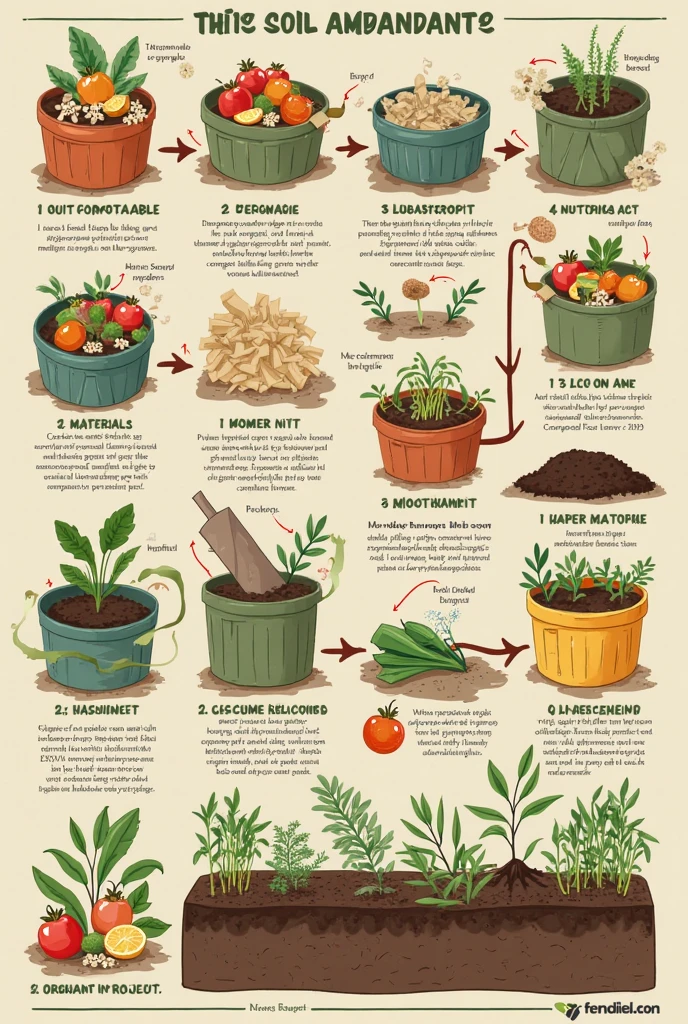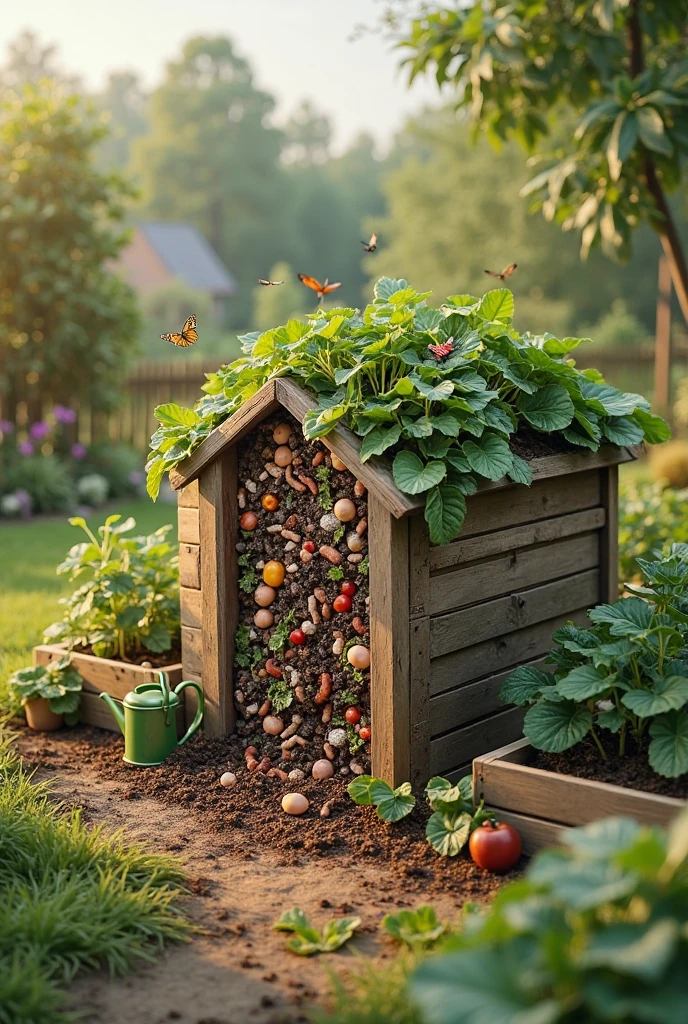
Table of Contents
Introduction
Composting at home is more than just an eco-friendly trend—it’s a powerful way to reduce landfill waste, nourish your garden naturally, and live a more sustainable life. With growing environmental awareness across the USA, millions of households are embracing home composting as a daily ritual.
In this comprehensive Step-by-Step Guide to Successful Home Composting, we’ll walk you through everything you need to start and maintain your own compost pile, even if you live in a small apartment or a spacious backyard.
What is Home Composting?
Home composting is the process of turning your organic waste—like fruit peels, vegetable scraps, coffee grounds, and yard trimmings—into rich, nutrient-dense soil conditioner called compost. This “black gold” helps your garden thrive without the use of synthetic fertilizers.
Benefits of Home Composting
| Benefit | Description |
|---|---|
| Reduces Waste | Cuts down on landfill use and methane emissions |
| Saves Money | Reduces need for commercial fertilizers |
| Eco-Friendly | Supports a circular, zero-waste lifestyle |
| Soil Enrichment | Adds nutrients and improves soil structure |
| Encourages Biodiversity | Attracts beneficial worms and microbes |
Internal Link: Learn more about sustainable gardening
Materials You Can Compost at Home
Green (Nitrogen-rich) Materials
- Vegetable scraps
- Coffee grounds
- Fruit peels
- Fresh grass clippings
- Tea bags
Brown (Carbon-rich) Materials
- Dry leaves
- Shredded newspaper
- Cardboard pieces
- Egg cartons
- Sawdust
Avoid meat, dairy, oily foods, pet waste, and diseased plants.
Tools & Supplies You’ll Need
| Tool | Purpose |
|---|---|
| Compost bin | To store and manage compost |
| Pitchfork or shovel | For turning the compost |
| Garden gloves | For safety and cleanliness |
| Thermometer (optional) | To check internal compost temperature |
| Spray bottle or hose | To adjust moisture levels |
External Link: Recommended composting bins from Home Depot
Step-by-Step Guide to Successful Home Composting

Step 1: Choose a Composting Location
Pick a convenient, shaded area near a water source. It can be:
- A backyard corner
- Balcony (with a sealed bin)
- Kitchen under-sink area (using indoor compost bins)
Step 2: Set Up Your Compost Bin
You can buy a ready-made bin or DIY it using a garbage can or wooden box. Ensure:
- Good airflow (vent holes)
- Easy access for turning
- Drainage holes to prevent excess moisture
Step 3: Add Green and Brown Layers
Alternate layers of green and brown materials:
- Start with a brown layer (e.g., shredded newspaper)
- Add green waste (e.g., veggie scraps)
- Repeat and mix periodically
This layering ensures proper carbon-nitrogen balance, crucial for fast decomposition.
Step 4: Maintain the Right Moisture
Your compost should feel like a wrung-out sponge—not too wet, not too dry.
- If too dry → add greens or a little water
- If too wet → add browns or stir more frequently
Internal Link: How to reduce food waste in the kitchen
Step 5: Turn Your Compost Regularly
Every 7–10 days, stir or turn your compost using a pitchfork or shovel. This:
- Aerates the pile
- Speeds up decomposition
- Prevents odor build-up
How Long Does Compost Take?
| Composting Method | Time to Completion |
|---|---|
| Hot composting | 1–3 months |
| Cold composting | 6–12 months |
| Vermicomposting (worms) | 2–4 months |
Factors that affect speed:
- Size of materials
- Moisture level
- Air circulation
- Temperature (hotter = faster)
Signs Your Compost is Ready
You’ll know your compost is finished when:
- It’s dark and crumbly
- Earthy smell (not rotten)
- No visible food scraps remain
- Temperature has cooled
How to Use Finished Compost
- Garden beds – Mix into soil for veggies and flowers.
- Potted plants – Add a thin layer on top of potting mix.
- Lawn – Sprinkle as top dressing for grass health.
- Tree bases – Help nourish young saplings.
External Link: Compost use guidelines from NRCS USDA
Common Composting Problems & Fixes
| Problem | Cause | Fix |
|---|---|---|
| Bad smell | Too much green, poor airflow | Add browns, turn pile |
| Dry pile | Not enough moisture | Sprinkle water |
| Slow decomposition | Lack of nitrogen or turning | Add greens, mix well |
| Pests | Food scraps exposed | Bury scraps, cover with browns |
Indoor Composting Options (for Small Spaces)
- Bokashi bins (anaerobic fermentation)
- Worm composting (vermicomposting)
- Sealed countertop composters (odor-free, great for apartments)
These are great for people with limited outdoor space but still want to enjoy successful home composting.
Internal Link: Guide to vermicomposting for beginners
Expert Tips for Successful Composting
- Chop or shred materials for faster breakdown.
- Keep a small container in the kitchen for daily scraps.
- Don’t overthink! Nature knows how to decompose.
- Share extra compost with neighbors or community gardens.
External Link: Composting tips from U.S. Environmental Protection Agency
Composting Laws & Community Programs in the USA
Did you know many U.S. cities now offer municipal compost pickup programs?
States like California, Vermont, and Washington encourage or mandate composting for residents. You can check with your local city council or waste management department for:
- Drop-off centers
- Free compost bins
- Workshops and rebates
External Link: Check local composting policies via RecycleNow
Tags Table
| Tags |
|---|
| home composting |
| composting tips |
| sustainable living |
| backyard compost |
| eco-friendly gardening |
| zero-waste lifestyle |
| DIY compost bin |
| composting USA |
| natural fertilizer |
Why Home Composting is a 2025 Trend in the USA
- Climate change awareness is growing.
- Urban farming and gardening are booming.
- DIY culture and zero-waste lifestyles are now mainstream.
Millions of Americans are realizing that home composting is simple, practical, and powerful for both the planet and their gardens.
Conclusion
Composting at home doesn’t require a farm, fancy equipment, or a green thumb. With this Step-by-Step Guide to Successful Home Composting, you now have all the knowledge you need to turn everyday kitchen waste into rich soil food.
Start small, stay consistent, and soon you’ll be harvesting compost like a pro. Your garden—and the planet—will thank you.